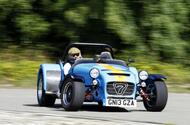Caterham CEO: ‘I’d love to produce an aluminium-chassis Seven’
 Off the back of its strong 2017 results, Caterham has ambitious plans for the future
Off the back of its strong 2017 results, Caterham has ambitious plans for the future
Caterham CEO Graham MacDonald has told Autocar that the brand’s recent sales success has reignited his desire to produce an aluminium version of the Seven.
Following the announcement that Caterham had achieved an 8% growth in annual sales in 2017, MacDonald said that while no solid plans were currently in place, he “loved” the idea of a Seven based around a “milled aluminium chassis”.
“If you look at a Norton bike, the aluminium work on that is a piece of art,” he said. “I would love for our customers to look at a Caterham’s suspension as a piece of art as well as engineering.”
Seven models use a steel tube chassis and aluminium body panels, but MacDonald (pictured below) believes growing demand – Caterham deliveries hit a 20-year high in 2017 – has given his company the financial security to consider developing the car for the future, so long as it remains true to the Seven's 61-year heritage.
“I recognise that the automotive landscape is changing, and changing quickly,” he said. “But the Seven has been built for more than 60 years and we’ll continue to build the car with the same lightweight and effective handling as always.”

MacDonald said that a more pressing challenge for the Sussex-based car maker came with finding new powertrains that are suitable for a traditional lightweight sports car that’s as raw as the Seven.
“The Ford Sigma and Duratec engines [which Caterham uses in most of its cars] are coming to the end of their production lifetimes,” MacDonald said, “so we’re looking at various options for their replacements.”
Caterham boss: "Autonomous and electric cars are an opportunity"
MacDonald ideally wants to avoid turbocharging in core Caterham models but conceded that it may eventually be necessary, largely because there are a very limited number of naturally aspirated engines still available on the market.
The entry-level Caterham 160 already uses a turbocharged Suzuki 660cc three-cylinder engine with 80bhp, while the range-topping 620 R uses a Ford-built supercharged 2.0-litre powerplant that makes 310bhp.
But the breadth of the Seven range, which is comprised of the 270, 360 and 420, all use naturally aspirated four-cylinder engines.
“I think we’ve always tried to keep away from turbocharged engines, but with the WLTP [new Worldwide Harmonised Light Vehicle Test Procedure that enforces stricter emissions limits] we’ll have to get the cars homologated to the new European standard,” MacDonald said, “although we’re quite pleased that we’re not far away from where we need to be already.”

MacDonald also believes that last year’s sales of 667 units, equating to a 51-car increase on 2016, illustrates a growing global market for driver's cars that Caterham can tap into. He revealed that in some markets, dealers are taking “10 or 20 deposits” for Sevens as buyers want to secure their build slot as quickly as possible.
“Our team recognises that the US market is a big opportunity, because while we currently have to send cars there in kit form [to bestow them with kit-car exemption from federal regulations], there’s talk of them opening up to historical classics, which we’d fall into," he said.
"And I’m also convinced there are more markets for growing our motorsport [championships], such as China, Russia and emerging countries where wealthy entrepreneurs want to go racing."
MacDonald believes the recent growth experienced by Caterham is therefore not short-lived, but the result of the hard work that he and his team have put in to drag the brand out of “tormentous times” following the collapse of the Caterham Formula 1 team in 2014.
“We’ve worked hard to get the product range and core markets to where they are now, so we can hopefully start to reinvest that into the business,” he said. “If there’s one problem I have, its that we can’t build the cars fast enough. It’s a good problem to have.”
More content:
Comments
Post a Comment